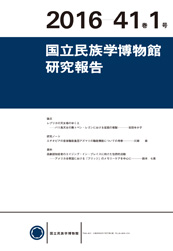Bulletin of the National Museum of Ethnology
Contents
- Articles
- How Replicated Masks Work in Balinese Society: The Case of Topeng Legong
Yoshida, Yukako - Research Notes
- Analysis of the Occupational Function of Azmari Occupational Musicians in Ethiopia
Kawase, Itsushi - Research Information
- Exploration of Inclusion toward the Aging-in-place of Older Adults Living with Dementia: Focusing on Memory Care Conducted by “Bridges” in the United States
Suzuki, Nanami
Outline
Articles
How Replicated Masks Work in Balinese Society:
The Case of Topeng Legong
Yukako Yoshida
Topeng legong is a ritual dance in which masks representing celestials are worn by little girls. This highly sacred dance has received special attention because of its sacred nature, history, authenticity, and beauty.
Currently, there are two sets of masks used in topeng legong. One set consists of centuries-old masks believed to possess magical powers for protection; the other set comprises replicas. The replica masks were made when topeng legong dancers were invited to perform in an art festival in 1988. Ketewel locals were afraid that their sacred masks might be “defiled” if brought to a secular context or place, so they decided to create replicas assubstitutes.
At first glance, people seem to differentiate sufficiently between secular performances and religious rites by using non-sacred masks. However, the actual situation is more complicated. Some regard the replicas as “children” of the original ones, and show respect for them. Some cannot distinguish the replicas from the originals. The meaning and role of the replicas are thus ambiguous and inconsistent.
In this study, I argue that because of that ambiguous status, the replica masks have generated unique and interesting effects on the development of topeng legong and its original masks.
Key Words:mask, material agent, replica, topeng legong, Bali
Research Notes
Analysis of the Occupational Function of Azmari Occupational Musicians in Ethiopia
Itsushi Kawase
The Azmari are occupational musicians, active in the society of northern Ethiopia, who play one-stringed fiddles called masinqos. The Azmari, having alternately been described as clowns, wandering minstrels, political agitators, social critics, spokespersons of the community, and singers serving princes and the nobility, have played multiple roles throughout the ages in Ethiopia. However, few analyses have been made of their musical activities from a musicological perspective, causing the picture of the Azmari to remain quite vague in relation to their sociocultural background.
The paper will give an ethnographic report of the Azmari, examining their song texts and occupational roles, based on a case study of a group in Gondar, specifically treating their activities as a profession based on frequent interactions with audiences in society.
Key Words:Ethiopia, occupational musicians, Azmari
Research Information
Exploration of Inclusion toward the Aging-in-place of Older Adults Living with Dementia: Focusing on Memory Care Conducted by “Bridges” in the United States
Nanami Suzuki
This article explores the development of so-called “memory care” in the United States, which aims to diminish the emotional isolation of older adults with dementia and promote their aging-in-place by connecting them to other people. The practice has been carried out in certain cases via face-to-face meetings of volunteers known as “Bridges” (persons who connect) and older adults with dementia known as “Buddies” (fellows).
Since 2005, exchanges for memory care have been practiced under a curriculum conducted in collaboration between a nonprofit organization (NPO) called Memory Bridge and secondary schools (i.e., junior and senior high schools). From 2006 to 2010, the Chicago Memory Bridge Initiative (CMBI) connected over 7,500 secondary students with older adults suffering from dementia through one-to-one relationships that lasted a minimum of three months. The Buddies were positioned as the guides and teachers of the Bridges in meetings devoted to memory care. Memory Bridge also trained over one hundred hospice staff members and volunteers how to associate with people with dementia in emotionally nourishing ways.
The article investigates the experiences of the Bridges and considers the meaning of memory care by focusing on the practice, conducted since 2013, at a Continuing Care Retirement Community (CCRC) in Florida—where the aging rate is higher than the U.S. average—based on exploratory fieldwork research conducted in November and December 2015.
Key Words:older adults with dementia or cognitive impairments, emotional isolation, agingin-place, memory care, Bridge, Buddy, United States
 2016-Vol. 41, No. 1
2016-Vol. 41, No. 1




